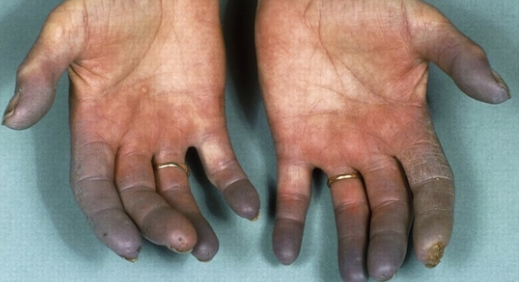Makindo Medical Notes"One small step for man, one large step for Makindo" |
|
|---|---|
| Download all this content in the Apps now Android App and Apple iPhone/Pad App | |
| MEDICAL DISCLAIMER: The contents are under continuing development and improvements and despite all efforts may contain errors of omission or fact. This is not to be used for the assessment, diagnosis, or management of patients. It should not be regarded as medical advice by healthcare workers or laypeople. It is for educational purposes only. Please adhere to your local protocols. Use the BNF for drug information. If you are unwell please seek urgent healthcare advice. If you do not accept this then please do not use the website. Makindo Ltd. |
Buerger disease (Thromboangiitis obliterans )
-
| About | Anaesthetics and Critical Care | Anatomy | Biochemistry | Cardiology | Clinical Cases | CompSci | Crib | Dermatology | Differentials | Drugs | ENT | Electrocardiogram | Embryology | Emergency Medicine | Endocrinology | Ethics | Foundation Doctors | Gastroenterology | General Information | General Practice | Genetics | Geriatric Medicine | Guidelines | Haematology | Hepatology | Immunology | Infectious Diseases | Infographic | Investigations | Lists | Microbiology | Miscellaneous | Nephrology | Neuroanatomy | Neurology | Nutrition | OSCE | Obstetrics Gynaecology | Oncology | Ophthalmology | Oral Medicine and Dentistry | Paediatrics | Palliative | Pathology | Pharmacology | Physiology | Procedures | Psychiatry | Radiology | Respiratory | Resuscitation | Rheumatology | Statistics and Research | Stroke | Surgery | Toxicology | Trauma and Orthopaedics | Twitter | Urology
Related Subjects: Ankle-Brachial pressure Index (ABPI) and Peripheral Vascular Disease Peripheral Arterial Disease (PAD) Abdominal Aortic Aneurysm (AAA) Carotid Endarterectomy Buerger's disease (Thromboangiitis obliterans ) Leriche syndrome (aortoiliac occlusive disease)
🩸 Thromboangiitis Obliterans (Buerger’s Disease) is a rare, non-atherosclerotic, segmental vasculitis strongly linked to tobacco 🚬 use. It causes inflammation and thrombosis of small–medium arteries and veins in the distal extremities, with secondary nerve involvement ⚡. Most often seen in young male smokers (20–40 years), the disease is virtually absent in lifelong non-smokers — highlighting the pathogenic role of nicotine.
📌 About
- 👨 Demographics: Young male smokers, peak incidence in the late 20s–30s.
- 🌍 Distribution: Higher prevalence in Mediterranean, Middle Eastern, and South Asian populations.
- 🩺 Presentation: Progressive distal claudication, rest pain, and critical ischaemia → may culminate in ulcers or gangrene 🦶.

🧪 Aetiology & Pathophysiology
- 🔥 Inflammatory Vasculitis: Segmental panarteritis with thrombus formation and recanalisation → affects arteries, veins, and adjacent nerves.
- 🆚 Not Atherosclerosis: Affects younger patients, distal vessels, and shows no lipid-rich plaques.
- 🚬 Tobacco Exposure: Central pathogenic trigger; even small amounts (smoking/chewing) can sustain disease. Cessation is the only proven disease-modifying step ✅.
- ⚡ Structures Involved: Arterial occlusions, migratory superficial thrombophlebitis, and distal neuropathy.
🩺 Clinical Features
- 🚶 Claudication: Limb pain on exertion → worsens with progression.
- 😖 Rest Pain: Severe nocturnal pain due to critical ischaemia.
- 🖐️ Digital Ischaemia: Ulcers, gangrene, and loss of digits possible.
- ✋ Pulses: Proximal pulses often intact; distal pulses absent early.
- 🩹 Phlebitis Migrans: Painful, migrating superficial vein inflammation.
📑 Shionoya Clinical Criteria
Helps differentiate from other vasculopathies:
- 1️⃣ Tobacco history (smoking/chewing).
- 2️⃣ Onset before 50 years.
- 3️⃣ Infrapopliteal arterial occlusion.
- 4️⃣ Either upper limb involvement or migratory phlebitis.
- 5️⃣ Absence of other major atherosclerotic risk factors (e.g. diabetes, hyperlipidaemia).
🔍 Investigations
- 🧪 Bloods: ESR/CRP usually normal → helps exclude systemic vasculitis.
- 🖼️ Angiography: Gold standard → shows “corkscrew” collaterals and segmental occlusions 🌳.
- 📡 Doppler US: Useful for flow assessment, less definitive than angiography.
💊 Management
- 🚭 Tobacco Cessation: Absolute cornerstone — the only intervention that halts progression.
- 💊 Medical Therapy:
- 🩸 Aspirin/antiplatelets – limited efficacy.
- 🌬️ Calcium channel blockers – may reduce vasospasm.
- 💉 IV Iloprost (prostacyclin analogue) – may improve rest pain and ulcer healing.
- 🔪 Surgical/Procedural:
- 🧠 Sympathectomy – temporary pain relief.
- 🦵 Amputation – required in non-healing gangrene.
- 🩻 Revascularisation – rarely feasible (distal disease).
- 🤲 Supportive Care: Analgesia, wound care, and neuropathic pain management.
📉 Prognosis
- ✅ Improves with Cessation: Stopping tobacco can halt or reverse symptoms in many patients.
- ❌ Poor if Smoking Continues: Progression to ulcers, gangrene, and amputations is common.
- ⚖️ Quality of Life: Pain, disability, and limb loss cause significant morbidity.
📚 References
Case – Buerger disease (Thromboangiitis obliterans)
A 34-year-old man with a 12-year history of heavy cigarette smoking presents with rest pain in the toes, recurrent digital ulcers, and past episodes of migratory superficial thrombophlebitis. Exam shows cool, cyanotic fingers and toes with diminished distal pulses but preserved femoral pulses; Allen’s test is abnormal bilaterally. Labs are unremarkable (normal HbA1c, lipids, autoimmune screen), excluding diabetes and systemic vasculitis. Duplex reveals distal tibial/radial disease; angiography shows segmental distal occlusions with “corkscrew” collaterals, classic for Buerger. Diagnosis: thromboangiitis obliterans, a tobacco-driven, non-atherosclerotic inflammatory occlusive vasculopathy of small/medium arteries and veins. Management hinges on absolute nicotine cessation (including vaping/patches), foot care and ulcer protection, analgesia, and vasodilator therapy (e.g., IV iloprost for critical ischaemia). Consider sympathectomy or spinal cord stimulation for refractory pain/ischaemia; revascularisation is usually not feasible due to distal distribution. Educate regarding high risk of amputation if nicotine exposure continues; involve smoking cessation services and vascular surgery follow-up.